| Listing 1 - 10 of 12 | << page >> |
Sort by
|
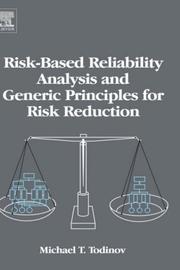
ISBN: 9780080447285 0080447287 9786610746675 128074667X 0080467555 9780080467559 Year: 2007 Publisher: Amsterdam Elsevier
Abstract | Keywords | Export | Availability | Bookmark
 Loading...
Loading...Choose an application
- Reference Manager
- EndNote
- RefWorks (Direct export to RefWorks)
For a long time, conventional reliability analyses have been oriented towards selecting the more reliable system and preoccupied with maximising the reliability of engineering systems. On the basis of counterexamples however, we demonstrate that selecting the more reliable system does not necessarily mean selecting the system with the smaller losses from failures! As a result, reliability analyses should necessarily be risk-based, linked with the losses from failures. Accordingly, a theoretical framework and models are presented which form the foundations of the reliability analysis and reliability allocation linked with the losses from failures. An underlying theme in the book is the basic principle for a risk-based design: the larger the cost of failure associated with a component, the larger its minimum necessary reliability level. Even identical components should be designed to different reliability levels if their failures are associated with different losses. According to a classical definition, the risk of failure is a product of the probability of failure and the cost given failure. This risk measure however cannot describe the risk of losses exceeding a maximum acceptable limit. Traditionally the losses from failures have been 'accounted for' by the average production availability (the ratio of the actual production capacity and the maximum production capacity). As demonstrated in the book by using a simple counterexample, two systems with the same production availability can be characterised by very different losses from failures. As an alternative, a new aggregated risk measure based on the cumulative distribution of the potential losses has been introduced and the theoretical framework for risk analysis based on the concept potential losses has also been developed. This new risk measure incorporates the uncertainty associated with the exposure to losses and the uncertainty in the consequences given the exposure. For repairable systems with complex topology, the distribution of the potential losses can be revealed by simulating the behaviour of systems during their life-cycle. For this purpose, fast discrete event-driven simulators are presented capable of tracking the potential losses for systems with complex topology, composed of a large number of components. The simulators are based on new, very efficient algorithms for system reliability analysis of systems comprising thousands of components. An important theme in the book are the generic principles and techniques for reducing technical risk. These have been classified into three major categories: preventive (reducing the likelihood of failure), protective (reducing the consequences from failure) and dual (reducing both, the likelihood and the consequences from failure). Many of these principles (for example: avoiding clustering of events, deliberately introducing weak links, reducing sensitivity, introducing changes with opposite sign, etc.) are discussed in the reliability literature for the first time. Significant space has been allocated to component reliability. In the last chapter of the book, several applications are discussed of a powerful equation which constitutes the core of a new theory of locally initiated component failure by flaws whose number is a random variable. This book has been written with the intention to fill two big gaps in the reliability and risk literature: the risk-based reliability analysis as a powerful alternative to the traditional reliability analysis and the generic principles for reducing technical risk. I hope that the principles, models and algorithms presented in the book will help to fill these gaps and make the book useful to reliability and risk-analysts, researchers, consultants, students and practising engineers. - Offers a shift in the existing paradigm for conducting reliability analyses. - Covers risk-based reliability analysis and generic principles for reducing risk. - Provides a new measure of risk based on the distribution of the potential losses from failure as well as the basic principles for risk-based design. - Incorporates fast algorithms for system reliability analysis and discrete-event simulators. - Includes the probability of failure of a structure with complex shape expressed with a simple equation.
Reliability (Engineering) --- System failures (Engineering) --- Risk assessment. --- Fiabilité --- Pannes --- Evaluation du risque --- ELSEVIER-B EPUB-LIV-FT
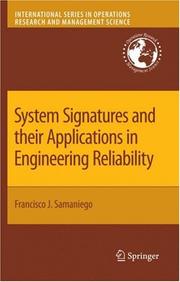
ISBN: 9780387717968 038771796X 9786611043766 1281043761 0387717978 Year: 2007 Volume: 110 Publisher: New York : Springer,
Abstract | Keywords | Export | Availability | Bookmark
 Loading...
Loading...Choose an application
- Reference Manager
- EndNote
- RefWorks (Direct export to RefWorks)
In building reliability into a system, engineers must address a number of practical needs that will enable them to quantify and compare reliability in engineered systems. (1) One is to be able to compare the reliability of one system to another system. (2) Another practical need is to compare alternate system designs for the purpose of engineering a particular optimal system. The practical, standardized, technical tool for characterizing reliability in systems is system signatures which was created in 1985 and since has developed into a powerful tool for qualifying reliability. It is used in all physical structures and stochastic systems where reliability is an important consideration (e.g., automobiles, bridges, electronic networks, airplanes, etc.) Since the introduction of system signatures in Francisco Samaniego’s 1985 paper, the properties of this technical concept have been examined, tested and proven in a wide variety of systems applications. Based on the practical and research success in building reliability into systems with system signatures, this is the first book treatment of the approach. It is, therefore, the purpose of this book to provide guidance on how reliability problems might be structured, modeled and solved. Over the past ten years the broad applicability of system signatures has become apparent and the tool’s utility in coherent systems and communications networks firmly established. The book compared actual system lifetimes where the tool has been and has not been used. These comparisons—which have been done over the years—demonstrate the practical, feasible and fruitful use of the tool in building reliable systems. Finally, new results and future directions for system signatures are also explored. .
Reliability (Engineering) --- Engineering systems --- Fiabilité --- Systèmes d'ingénierie --- Engineering systems. --- Maintainability (Engineering). --- Reliability (Engineering) -- Statistical methods. --- Reliability (Engineering). --- Distribution (Probability theory) --- Industrial & Management Engineering --- Technology - General --- Materials Science --- Chemical & Materials Engineering --- Mechanical Engineering --- Engineering & Applied Sciences --- Statistical methods. --- Fiabilité --- Systèmes d'ingénierie --- EPUB-LIV-FT LIVINGEN SPRINGER-B --- Engineering. --- Operations research. --- Decision making. --- System theory. --- Probabilities. --- Statistics. --- Quality control. --- Reliability. --- Industrial safety. --- Quality Control, Reliability, Safety and Risk. --- Statistics for Engineering, Physics, Computer Science, Chemistry and Earth Sciences. --- Probability Theory and Stochastic Processes. --- Operation Research/Decision Theory. --- Systems Theory, Control. --- Mathematical statistics --- Engineering
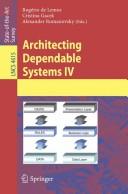
ISBN: 9783540740339 3540740333 354074035X Year: 2007 Publisher: Berlin, Germany ; New York, New York : Springer,
Abstract | Keywords | Export | Availability | Bookmark
 Loading...
Loading...Choose an application
- Reference Manager
- EndNote
- RefWorks (Direct export to RefWorks)
As software systems become ubiquitous, the issues of dependability become more and more crucial. Given that solutions to these issues must be considered from the very beginning of the design process, it is reasonable that dependability is addressed at the architectural level. This book was born of an effort to bring together the research communities of software architectures and dependability. This state-of-the-art survey contains 18 expanded and peer-reviewed papers based on the carefully selected contributions to the Workshop on Architecting Dependable Systems (WADS 2006), organized at the 2006 International Conference on Dependable Systems and Networks (DSN 2006), held in Philadelphia, PA, USA, in June 2006. It also contains a number of invited papers written by recognized experts in the area. The papers are organized in topical sections on architectural description languages, architectural components and patterns, architecting distributed systems, and architectural assurances for dependability.
Computer architecture --- Computer systems --- Fault-tolerant computing --- Ordinateurs --- Systèmes informatiques --- Tolérance aux fautes (Informatique) --- Congresses. --- Reliability --- Architecture --- Congrès --- Fiabilité --- Computer Science --- Engineering & Applied Sciences --- Information Technology --- Software Engineering --- Computer science. --- Architecture, Computer. --- Software engineering. --- Operating systems (Computers). --- Computer Science. --- Computer System Implementation. --- Software Engineering. --- Operating Systems. --- Computer operating systems --- Computers --- Disk operating systems --- Systems software --- Computer software engineering --- Engineering --- Architecture, Computer --- Informatics --- Science --- Operating systems --- Computer network architectures. --- Architectures, Computer network --- Network architectures, Computer
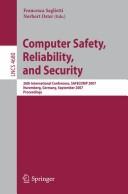
ISBN: 9783540751007 3540751009 3540751017 Year: 2007 Publisher: Berlin, Germany ; New York, New York : Springer,
Abstract | Keywords | Export | Availability | Bookmark
 Loading...
Loading...Choose an application
- Reference Manager
- EndNote
- RefWorks (Direct export to RefWorks)
Since 1979, when it was ?rst established by the Technical Committee on Re- ability, Safety and Security of the European Workshop on Industrial Computer Systems (EWICS TC7), the SAFECOMP Conference series has regularly and continuously contributed to improving the state of the art of highly depe- able computer-based systems, since then increasingly applied to safety-relevant industrial domains. Inthisexpandingtechnical?eldSAFECOMPo?ersaplatformforknowledge andtechnologytransferbetweenacademia,industry,researchandlicensingins- tutions, providing ample opportunities for exchanging insights, experiences and trends in the areas of safety, reliability and security regarding critical computer applications. In accordance with the growing spread of critical infrastructures involving both safety and security threats, this year’s SAFECOMP program included a considerable number of contributions addressing technical problems and engineering solutions across the border between safety-related and securi- related concerns. Thereactiontoourcallforpaperswasparticularlygratifyingandimpressive, including 136 full papers submitted by authors representing 29 countries from Europe,Asia, North and South America aswell asAustralia. The selection of 33 fullpapersand16shortpapersforpresentationandpublicationwasachallenging task requiring a huge amount of reviewing and organizational e?ort. In view of the particularly high number of articles submitted, obvious practical constraints led – to our regret – to the rejection of a considerable amount of high-quality work. To all authors, invited speakers, members of the International Program Committee and external reviewers go our heartfelt thanks! The local organization of SAFECOMP 2007, hosted in Nuremberg, is also gratefully acknowledged.
Computer software --- Electronic digital computers --- Computer security --- Logiciels --- Ordinateurs --- Sécurité informatique --- Reliability --- Congresses. --- Fiabilité --- Congrès --- Industrial safety --- Computer Science --- Engineering & Applied Sciences --- Computer science. --- Special purpose computers. --- Software engineering. --- Coding theory. --- Computer logic. --- Management information systems. --- Computer Science. --- Software Engineering/Programming and Operating Systems. --- Coding and Information Theory. --- Special Purpose and Application-Based Systems. --- Logics and Meanings of Programs. --- Management of Computing and Information Systems. --- Computer-based information systems --- EIS (Information systems) --- Executive information systems --- MIS (Information systems) --- Sociotechnical systems --- Information resources management --- Management --- Computer science logic --- Logic, Symbolic and mathematical --- Data compression (Telecommunication) --- Digital electronics --- Information theory --- Machine theory --- Signal theory (Telecommunication) --- Computer programming --- Computer software engineering --- Engineering --- Special purpose computers --- Computers --- Informatics --- Science --- Communication systems --- Logic design. --- Information Systems. --- Design, Logic --- Design of logic systems --- Electronic circuit design --- Logic circuits --- Switching theory --- Information theory. --- Communication theory --- Communication --- Cybernetics
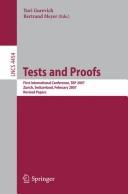
ISBN: 9783540737698 3540737693 3540737707 Year: 2007 Publisher: Berlin, Heidelberg : Springer Berlin Heidelberg : Imprint: Springer,
Abstract | Keywords | Export | Availability | Bookmark
 Loading...
Loading...Choose an application
- Reference Manager
- EndNote
- RefWorks (Direct export to RefWorks)
This book constitutes the thoroughly refereed post-proceedings of the First International Conference on Test and Proofs, TAP 2007, held in Zurich, Switzerland in February 2007. The 12 revised full papers presented were carefully reviewed and selected for inclusion in the book. The papers are devoted to the convergence of software proofing and testing and feature current research work that combines ideas from both sides to foster software quality. Topics addressed are generation of test cases or oracles by theorem proving, constraint logic programming, model checking, or symbolic execution; program proving with the aid of testing techniques; automatic tools; case studies; formal frameworks; as well as verification techniques combining proofs and tests.
Computer software --- Logiciels --- Testing --- Congresses. --- Reliability --- Quality control --- Essais --- Congrès --- Fiabilité --- Qualité --- Contrôle --- Computer Science --- Engineering & Applied Sciences --- Computer science. --- Computer communication systems. --- Computer system failures. --- Software engineering. --- Computer logic. --- Computers and civilization. --- Computer Science. --- Computer Communication Networks. --- System Performance and Evaluation. --- Software Engineering. --- Logics and Meanings of Programs. --- Computers and Society. --- Civilization and computers --- Civilization --- Computer science logic --- Logic, Symbolic and mathematical --- Computer software engineering --- Engineering --- Computer failures --- Computer malfunctions --- Computer systems --- Failure of computer systems --- System failures (Engineering) --- Fault-tolerant computing --- Communication systems, Computer --- Computer communication systems --- Data networks, Computer --- ECNs (Electronic communication networks) --- Electronic communication networks --- Networks, Computer --- Teleprocessing networks --- Data transmission systems --- Digital communications --- Electronic systems --- Information networks --- Telecommunication --- Cyberinfrastructure --- Electronic data processing --- Network computers --- Informatics --- Science --- Failures --- Distributed processing --- Computer system performance. --- Logic design. --- Design, Logic --- Design of logic systems --- Digital electronics --- Electronic circuit design --- Logic circuits --- Machine theory --- Switching theory --- Computer networks.
Book
ISBN: 9783540732297 3540732292 9786610943975 1280943971 3540732306 Year: 2007 Publisher: Berlin ; Heidelberg : Springer-Verlag,
Abstract | Keywords | Export | Availability | Bookmark
 Loading...
Loading...Choose an application
- Reference Manager
- EndNote
- RefWorks (Direct export to RefWorks)
Reliable Software Technologies is an annual series of international conferences devoted to the promotion and advancement of all aspects of reliable software technologies. The objective of this series of conferences, initiated and sponsored by Ada-Europe, the European federation of national Ada societies, is to provide a forum to promote the development of reliable softwares both as an industrial technique and an academic discipline. Previous editions of the Reliable Software Technologies conference were held in: Porto (Portugal) in 2006, York (UK) in 2005, Palma de Mallorca (Spain) in 2004,Toulouse (France) in 2003,Vienna (Austria) in 2002,Leuven (Belgium) in 2001,Potsdam(Germany)in2000,Santander(Spain)in1999,Uppsala(Sweden) in 1998, London (UK) in 1997 and Montreux (Switzerland) in 1996. The 12th International Conference on Reliable Software Technologies took place in Geneva, Switzerland, June 25-29, 2007, under the continued sponsoring ofAda-Europe,incooperationwithACMSIGAda.Itwasorganizedbymembers of the University of Applied Sciences, Western Switzerland (Engineering School of Geneva), in collaboration with colleagues from various places in Europe. The 13th conference, in 2008, will take place in Venice, Italy.
Computer software --- Logiciels --- Reliability --- Congresses. --- Fiabilité --- Congrès --- Computer Science --- Engineering & Applied Sciences --- Information Technology --- Computer Science (Hardware & Networks) --- Software Engineering --- Computer systems --- ADP systems (Computer systems) --- Computing systems --- Systems, Computer --- Computer science. --- Computer communication systems. --- Special purpose computers. --- Computer programming. --- Software engineering. --- Programming languages (Electronic computers). --- Application software. --- Computer Science. --- Computer Applications. --- Software Engineering. --- Programming Techniques. --- Programming Languages, Compilers, Interpreters. --- Computer Communication Networks. --- Special Purpose and Application-Based Systems. --- Application computer programs --- Application computer software --- Applications software --- Apps (Computer software) --- Computer languages --- Computer program languages --- Computer programming languages --- Machine language --- Electronic data processing --- Languages, Artificial --- Computer software engineering --- Engineering --- Computers --- Electronic computer programming --- Electronic digital computers --- Programming (Electronic computers) --- Coding theory --- Special purpose computers --- Communication systems, Computer --- Computer communication systems --- Data networks, Computer --- ECNs (Electronic communication networks) --- Electronic communication networks --- Networks, Computer --- Teleprocessing networks --- Data transmission systems --- Digital communications --- Electronic systems --- Information networks --- Telecommunication --- Cyberinfrastructure --- Network computers --- Informatics --- Science --- Programming --- Distributed processing
Book
ISBN: 9780387736549 0387736549 0387736557 Year: 2007 Publisher: New York : Springer,
Abstract | Keywords | Export | Availability | Bookmark
 Loading...
Loading...Choose an application
- Reference Manager
- EndNote
- RefWorks (Direct export to RefWorks)
International Federation for Information Processing The IFIP series publishes state-of-the-art results in the sciences and technologies of information and communication. The scope of the series includes: foundations of computer science; software theory and practice; education; computer applications in technology; communication systems; systems modeling and optimization; information systems; computers and society; computer systems technology; security and protection in information processing systems; artificial intelligence; and human-computer interaction. Proceedings and post-proceedings of referred international conferences in computer science and interdisciplinary fields are featured. These results often precede journal publication and represent the most current research. The principal aim of the IFIP series is to encourage education and the dissemination and exchange of information about all aspects of computing. For more information about the 300 other books in the IFIP series, please visit www.springer.com. For more information about IFIP, please visit www.ifip.org.
Computer systems --- Trust --- Computers --- Computer security --- Electronic commerce --- Systèmes informatiques --- Confiance --- Ordinateurs --- Sécurité informatique --- Commerce électronique --- Reliability --- Congresses --- Access control --- Security measures --- Fiabilité --- Congrès --- Accès --- Contrôle --- Sécurité --- Mesures --- Computer security -- Congresses. --- Computer systems -- Reliability -- Congresses. --- Computers -- Access control -- Congresses. --- Electronic books. -- local. --- Electronic commerce -- Security measures -- Congresses. --- Trust -- Congresses. --- Computer Science --- Engineering & Applied Sciences --- Cybercommerce --- E-business --- E-commerce --- E-tailing --- eBusiness --- eCommerce --- Electronic business --- Internet commerce --- Internet retailing --- Online commerce --- Web retailing --- Trust (Psychology) --- Computer science. --- Computer security. --- Computer Science. --- Systems and Data Security. --- Computer privacy --- Computer system security --- Cyber security --- Cybersecurity --- Electronic digital computers --- Protection of computer systems --- Security of computer systems --- Data protection --- Security systems --- Hacking --- Informatics --- Science --- Protection --- Commerce --- Information superhighway --- Attitude (Psychology) --- Emotions
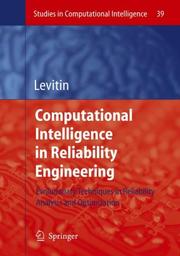
ISBN: 9783540373674 3540373675 9783540373711 3540373713 9786610727360 1280727365 3540373683 9786610745722 128074572X 3540373721 Year: 2007 Publisher: Berlin ; Heidelberg : Springer,
Abstract | Keywords | Export | Availability | Bookmark
 Loading...
Loading...Choose an application
- Reference Manager
- EndNote
- RefWorks (Direct export to RefWorks)
This book covers the recent applications of computational intelligence techniques in reliability engineering. This volume contains a survey of the contributions made to the optimal reliability design literature in the resent years and chapters devoted to different applications of a genetic algorithm in reliability engineering and to combinations of this algorithm with other computational intelligence techniques. Genetic algorithms are one of the most widely used metaheuristics, inspired by the optimization procedure that exists in nature, the biological phenomenon of evolution.
Reliability (Engineering) --- Computational intelligence. --- Fiabilité --- Intelligence informatique --- Electronic books. -- local. --- Reliability (Engineering). --- Engineering & Applied Sciences --- Civil & Environmental Engineering --- Applied Mathematics --- Civil Engineering --- Computational intelligence --- Mechanical Engineering --- Industrial & Management Engineering --- Intelligence, Computational --- Reliability of equipment --- Systems reliability --- Engineering. --- Artificial intelligence. --- Applied mathematics. --- Engineering mathematics. --- Quality control. --- Reliability. --- Industrial safety. --- Appl.Mathematics/Computational Methods of Engineering. --- Artificial Intelligence (incl. Robotics). --- Quality Control, Reliability, Safety and Risk. --- Applications of Mathematics. --- Computational Intelligence. --- Artificial intelligence --- Soft computing --- Industrial accidents --- Industries --- Job safety --- Occupational hazards, Prevention of --- Occupational health and safety --- Occupational safety and health --- Prevention of industrial accidents --- Prevention of occupational hazards --- Safety, Industrial --- Safety engineering --- Safety measures --- Safety of workers --- Accidents --- System safety --- Dependability --- Trustworthiness --- Conduct of life --- Factory management --- Industrial engineering --- Sampling (Statistics) --- Standardization --- Quality assurance --- Quality of products --- Engineering --- Engineering analysis --- Mathematical analysis --- AI (Artificial intelligence) --- Artificial thinking --- Electronic brains --- Intellectronics --- Intelligence, Artificial --- Intelligent machines --- Machine intelligence --- Thinking, Artificial --- Bionics --- Cognitive science --- Digital computer simulation --- Electronic data processing --- Logic machines --- Machine theory --- Self-organizing systems --- Simulation methods --- Fifth generation computers --- Neural computers --- Construction --- Industrial arts --- Technology --- Prevention --- Mathematics --- Maintainability (Engineering) --- Probabilities --- Systems engineering --- Plant performance --- Safety factor in engineering --- Structural failures --- System safety. --- Mathematics. --- Mathematical and Computational Engineering. --- Artificial Intelligence. --- Math --- Science --- Safety, System --- Safety of systems --- Systems safety --- Industrial safety
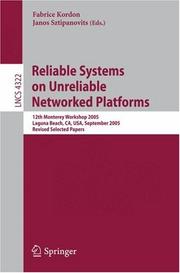
ISBN: 9783540711551 3540711554 9786610935789 1280935782 3540711562 Year: 2007 Publisher: Berlin, Heidelberg : Springer Berlin Heidelberg : Imprint: Springer,
Abstract | Keywords | Export | Availability | Bookmark
 Loading...
Loading...Choose an application
- Reference Manager
- EndNote
- RefWorks (Direct export to RefWorks)
Computer software --- Software architecture --- Computer systems --- Logiciels --- Systèmes informatiques --- Development --- Congresses. --- Reliability --- Développement --- Congrès --- Fiabilité --- Computer software -- Development -- Congresses. --- Computer systems -- Reliability -- Congresses. --- Electronic books. -- local. --- Software architecture -- Development -- Congresses. --- Computer Science --- Engineering & Applied Sciences --- Information Technology --- Software Engineering --- Architecture, Software --- Computer software architecture --- Architecture --- Design --- Computer science. --- Computer communication systems. --- Software engineering. --- Computer programming. --- Programming languages (Electronic computers). --- Computer logic. --- Computer Science. --- Software Engineering/Programming and Operating Systems. --- Software Engineering. --- Programming Techniques. --- Programming Languages, Compilers, Interpreters. --- Logics and Meanings of Programs. --- Computer Communication Networks. --- Computer science logic --- Logic, Symbolic and mathematical --- Computer languages --- Computer program languages --- Computer programming languages --- Machine language --- Electronic data processing --- Languages, Artificial --- Computers --- Electronic computer programming --- Electronic digital computers --- Programming (Electronic computers) --- Coding theory --- Computer software engineering --- Engineering --- Communication systems, Computer --- Computer communication systems --- Data networks, Computer --- ECNs (Electronic communication networks) --- Electronic communication networks --- Networks, Computer --- Teleprocessing networks --- Data transmission systems --- Digital communications --- Electronic systems --- Information networks --- Telecommunication --- Cyberinfrastructure --- Network computers --- Informatics --- Science --- Programming --- Distributed processing --- Logic design. --- Design, Logic --- Design of logic systems --- Digital electronics --- Electronic circuit design --- Logic circuits --- Machine theory --- Switching theory --- Programming languages (Electronic computers) --- Computer networks.
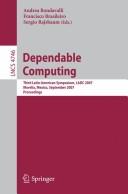
ISBN: 9783540752936 3540752935 3540752943 Year: 2007 Publisher: Berlin, Heidelberg : Springer Berlin Heidelberg : Imprint: Springer,
Abstract | Keywords | Export | Availability | Bookmark
 Loading...
Loading...Choose an application
- Reference Manager
- EndNote
- RefWorks (Direct export to RefWorks)
Fault-tolerant computing --- Electronic digital computers --- Tolérance aux fautes (Informatique) --- Ordinateurs --- Congresses. --- Reliability --- Congrès --- Fiabilité --- Computer Science --- Electrical Engineering --- Engineering & Applied Sciences --- Electrical & Computer Engineering --- Computer science. --- Logic design. --- Computer communication systems. --- Special purpose computers. --- Computer system failures. --- Software engineering. --- Coding theory. --- Computer Science. --- Computer Communication Networks. --- Special Purpose and Application-Based Systems. --- System Performance and Evaluation. --- Software Engineering. --- Logic Design. --- Coding and Information Theory. --- Data compression (Telecommunication) --- Digital electronics --- Information theory --- Machine theory --- Signal theory (Telecommunication) --- Computer programming --- Computer software engineering --- Engineering --- Computer failures --- Computer malfunctions --- Computer systems --- Failure of computer systems --- System failures (Engineering) --- Special purpose computers --- Computers --- Communication systems, Computer --- Computer communication systems --- Data networks, Computer --- ECNs (Electronic communication networks) --- Electronic communication networks --- Networks, Computer --- Teleprocessing networks --- Data transmission systems --- Digital communications --- Electronic systems --- Information networks --- Telecommunication --- Cyberinfrastructure --- Electronic data processing --- Network computers --- Design, Logic --- Design of logic systems --- Electronic circuit design --- Logic circuits --- Switching theory --- Informatics --- Science --- Failures --- Distributed processing --- Computer system performance. --- Information theory. --- Communication theory --- Communication --- Cybernetics --- Computer networks. --- Computers, Special purpose. --- Electronic digital computers—Evaluation.
| Listing 1 - 10 of 12 | << page >> |
Sort by
|

 Search
Search Feedback
Feedback About UniCat
About UniCat  Help
Help News
News